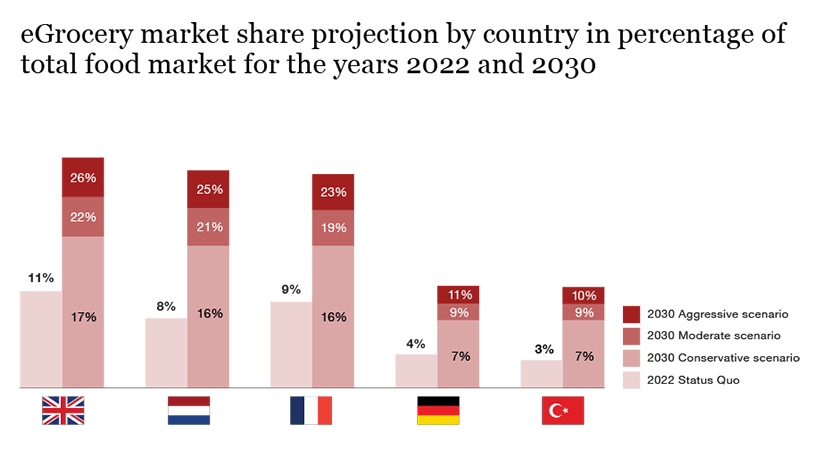
Two years of pandemic disruption caused a surge in online grocery shopping. However, there is no sign of a return to pre-Covid shopping habits, even amid weakening economies, surging inflation and rising interest rates. These challenges may slow the growth of eGrocery in the short term, but demand for online services from food retailers and the corresponding digitization of their operations is not going away. As a result, grocery shopping will be significantly different in the future and the winning business model will be omni-channel. Food retailers will need to fully integrate their physical and digital channels. Consumer expectations and behavior will shift as digital natives become a leading retail customer segment and all age groups increasingly embrace online shopping.
Based on our survey, grocery industry experts expect the market share of online grocery shopping to increase to between 35 and 50 percent in Germany, France, the UK, Turkey and the Netherlands by 2050. Retailers that wish to keep or grow their current market share by becoming leading omni-channel players need to launch eGrocery offerings early to gain the necessary expertise. Our study identifies the most important success factors for brick-and-mortar retailers’ transition to online grocery, provides insights on how the grocery shopping markets in Europe will evolve and become profitable, and presents high potential business models for different consumer needs.
How is the grocery market changing?
New business models are reinventing grocery shopping and meal preparation
eGrocery market share will rise significantly and the demand for online services from food retailers is not going away
Food retailers will need to fully integrate their physical and digital channels to an omni-channel business model

We are using a multiple regression analysis to establish a market model, estimate future eGrocery markets and calculate different possible scenarios. Every scenario predicts a rising market share. This market model projects that over the coming seven years the eGrocery market will grow significantly and reflects the need for retailers to take action now.
How grocery shopping in European markets will evolve
We consulted 57 industry experts - mainly from Germany, France, the United Kingdom, Turkey, and the Netherlands - about the likely changes in the grocery market between now and 2030. One key takeaway is that customers want a seamless and flexible customer journey across multiple channels. This includes:
- Omni-channel online and offline options
- One-stop shopping options
- Efficiency and speedy service during purchase, checkout, delivery or collection
- Constant availability
- Availability on a smartphone
- Diverse payment options
Picking the most promising eGrocery business models prevailing in the long term

When we asked which business models will be most likely to prevail in the long term, respondents predicted that traditional discounters and full-range retailers would endure alongside technology companies. But they were divided on the prospects for pure online retailers: 37 percent think they will very probably thrive, while 24 percent doubt their long-term success.
How online grocery will become profitable in the future
Our survey shows: Customers want a convenient online delivery service and there are plenty of companies offering that, so retailers cannot refuse to take part without losing market share. Around 90 percent of our survey respondents expect online grocery to be profitable by 2030. eGrocers have two broad routes to become profitable: they must sell more, at better margins; and they must find ways to cut costs. Without exception, companies will need to adapt and upgrade all operations, developing a lean discount assortment and tailored packaging for online order delivery, cost-efficient and automated last mile delivery, automated infrastructure and efficient picking, and low-cost payment solutions.
Time for retailers to act
As our research and survey responses make clear, online grocery retailing will make greater and greater inroads into the traditional market in the decade ahead. While brick-and-mortar stores will still have a significant market share, their revenue and profitability will be eroded as consumers take advantage of the convenience of new digital services. The full extent of the change to an omni-channel model and the exact road ahead are still unclear, but the grocery retailers already getting it right online are pointing the way.
Our study not only gives an idea of the future of grocery shopping across different countries in Europe, but also provides insights in fulfilment technologies that help online grocery become profitable, the most important success factors for brick-and-mortar retailers’ transition to online grocery and highlights the most urgent changes for retailers to stay a future driven player in the grocery shopping business.
Many thanks go to Felix Starke, Magdalena Worm and Jean Pujol for their advice and contributions to the analyses.
Contact us










